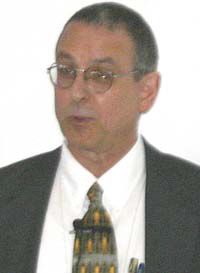| Dr. Raymond Levey speaks about natural gas development. |
The changing landscape-natural gas in the West
Dr. Raymond Levey, of the Energy and Geoscience Institute at the University of Utah conducted a breakout session at Sen. Bob Bennett’s Rural Business Conference in Price. “Energy is so important to the future of the West, and this Nation,” said Dr. Levey. He said the landscape of the West is shifting in the fossil fuel area.
Utah is the number one state in the percentage of residential natural gas users in the United States. Eighty-five percent of the homes in Utah use natural gas as opposed to the national average of 50 percent. According to the map he displayed, Utah is the center of natural gas production in the West. Availability may be a factor in the high number of residences who use natural gas.
The EGI at the U of U, works with fossil energy sources, and researches new, more efficient and less polluting ways to use them. EGI is the largest program of its type at any university in the world. They have been researching geothermal energy for more than 30 years. Geothermal is one of the three core research programs at the U. The others are fossil energy and carbon engineering.
“Taking carbon particles out of the atmosphere is vital to Utah,” said Dr. Levey. “Our research and the processes will be vital to other nations of the world. Our staff of 90 scientists is associated with 18 countries and 65 companies. Our staff has recently been asked to help with the consultation for the rebuilding of Iraq’s infrastructure.”
Dr. Levey said since 1980, the number of gas wells in the West has increased dramatically, and many more wells are on the way. In terms of a global perspective, most of the reserves of natural gas in the world have been produced.
The scientists are now looking into undiscovered resources and processes for their use. Some of these are coal bed methane, tar sands and gas shales. Other emerging future resources may be sub volcanic plays, shale plays, new tight gas plays, and deep coal bed methane.
“Technology will be the driving force in the future of energy production. There will be technological challenges to overcome. We must understand the unconventional resources. Utah has all the unconventional resources,” stated Dr. Levey.
Due to the cleanliness of natural gas, Dr. Levey predicted that natural gas use will grow increasingly. Natural gas produces less carbon dioxide emissions than other sources of conventional fossil fuel. It produces 30 percent less than oil, and 45 percent less than coal. It is the cleanest of the fossil fuels.
“Most of the new wells have been drilled in the West with 2006 and 2007 seeing the largest increase in production. All production in other conventional sources are on the decline. Natural gas is the only one on an upward trend,” added Dr. Levey.
He said Utah has an abundance of each of the types of sources being researched at the U of U. Gas shale and coal bed methane now account for 30 percent of the amount of natural gas produced in the U.S., and the Rocky Mountain area produces 20 percent of the gas used. Demand for natural gas is expected to increase 2 percent a year for the next 20 years.
“Utah has been severely underrated as to the number of cubic feet of potential reserve of the unconventional types of resources. Utah has all three, tight sands, coal bed methane and gas shale. Utah will play a big part in the production of natural gas in the future,” Dr. Levey stated.
Dr. Levey said with the technological advances in the drilling area and seismic survey methods, more of the usable reserve is being produced. These new methods allow more intensive well drilling and less waste in the drilling process.
He concluded with this thought, “The federal government is spending less and less on fossil energy research. The University of Utah is developing more and researching more ways to use the unconventional reserves in the West. Utah has had, and will continue to have, a significant role in the technology lessons we have learned.”

